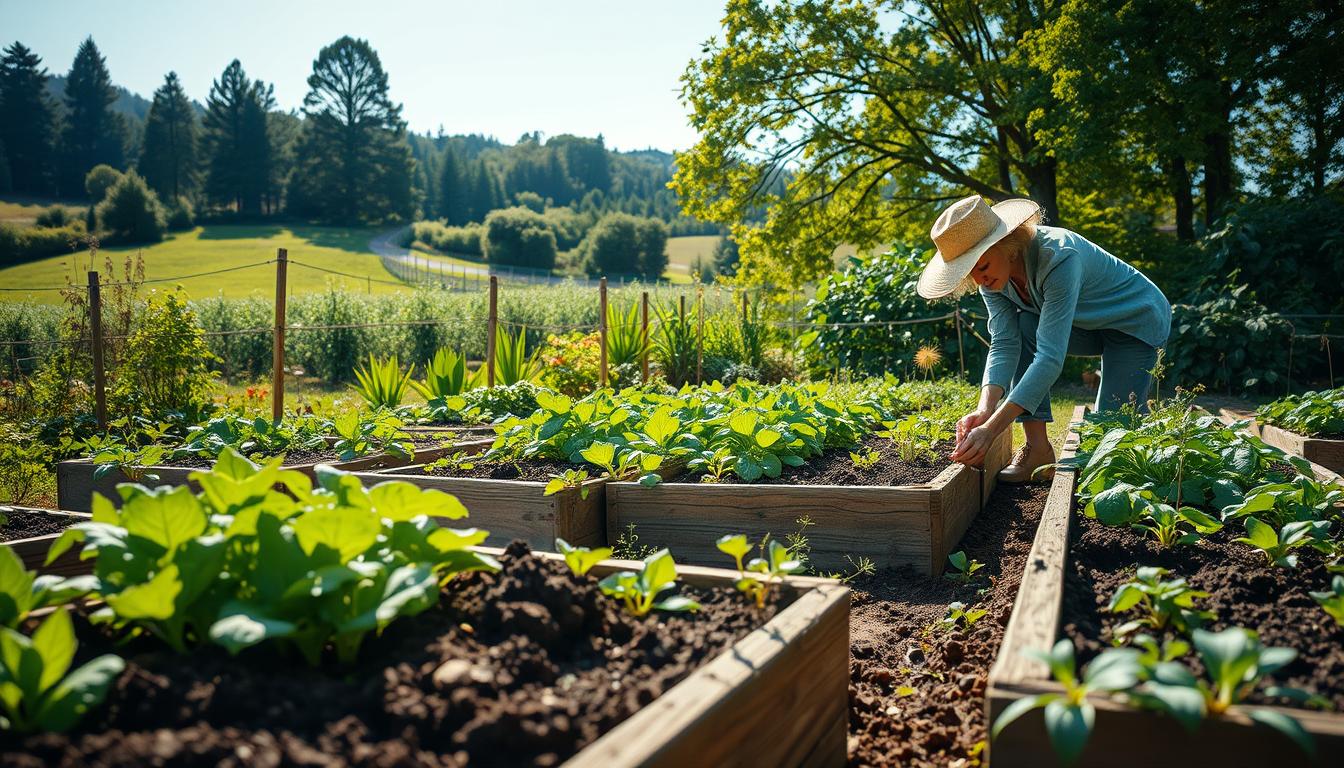Ever dreamed of a gardening method that works with nature? Welcome to no-dig gardening. It lets you grow plants while keeping the soil healthy. This method is loved by both new and experienced gardeners for its simplicity.
This method is easy because it follows nature’s lead. It lets plants grow with little help from you. The soil stays untouched, helping plants grow strong.
More gardeners are choosing sustainable gardening, and no-dig stands out. It’s easy on your body and makes plants healthier. In this article, we’ll show you how to make your garden better with these easy, earth-friendly tips.
What Is No-Dig Gardening?
No-dig gardening is a gentle way to garden that doesn’t harm the soil. It avoids the need for digging and tilling. Instead, it layers organic materials on top of the soil.
This method is like how leaves decompose in a forest, feeding the soil. It keeps the soil’s ecosystem intact. This ecosystem is full of microorganisms, fungi, and invertebrates that make the soil fertile.
The Philosophy Behind No-Dig Methods
No-dig gardening works with nature, not against it. It sees soil as a living ecosystem, not just a growing medium. This changes how we view our role in gardening.
It believes that soil organisms can create healthy soil better than we can. Earthworms and fungi help with water and air channels and nutrient access. This method focuses on feeding the soil life, which benefits your plants.
It also respects the natural layers of soil. Just like a forest floor, no-dig gardens develop beneficial layers. This happens when we stop mixing everything together.
Historical Roots and Modern Revival
No-dig gardening is not new; it’s a rediscovery of ancient wisdom. Traditional farming cultures worldwide have used minimal soil disturbance. This comes from observing and understanding natural systems for generations.
In the mid-20th century, Ruth Stout introduced no-dig gardening for home gardeners. Her method used deep hay mulches to suppress weeds and improve soil. Charles Dowding later showed the benefits of no-dig through his trials.
Today, no-dig gardening is more popular than ever. This is thanks to a better understanding of soil biology. Modern research confirms that undisturbed soil is healthier and more biodiverse. As gardeners look for sustainable ways to garden, no-dig methods are becoming more popular.
The Science of Soil Health in No-Dig Systems
No-dig gardening is more than just a gardening trick. It’s based on solid science and nature’s ways. By working with nature, we use ancient biological processes. This knowledge makes us better gardeners and earth stewards.
Understanding Soil Ecology and Microorganisms
Soil is alive, full of billions of tiny creatures in every handful. These tiny beings are key to soil health and plant growth in no-dig gardens.
Bacteria break down organic matter and release nutrients for plants. Fungi spread through the soil, helping nutrients move around. Protozoa and nematodes eat bacteria, making nitrogen available to plants.
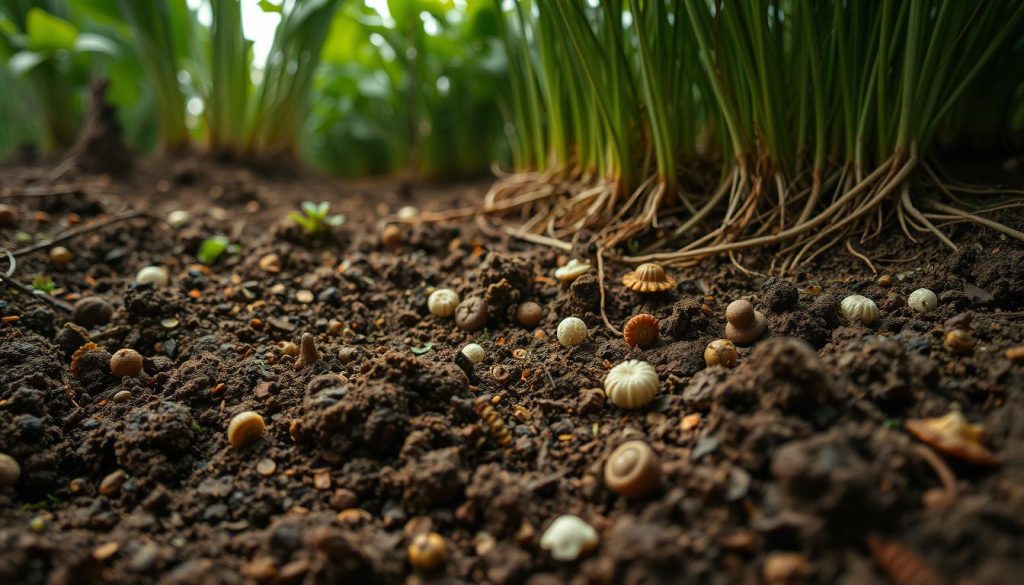
This underground network works best when left alone. Traditional gardening’s tilling harms these delicate systems. No-dig methods keep this community thriving, supporting plant growth naturally.
Soil microorganisms also make natural glues that improve soil structure. These glues help soil particles stick together, creating spaces for air and water. This is crucial for healthy roots.
How No-Dig Preserves Soil Structure
Soil structure is how particles come together. Good structure balances water and air, letting roots grow easily.
Digging or tilling ruins this natural setup. It harms microorganisms and breaks soil apart. It also burns the soil’s carbon by oxidizing organic matter.
No-dig gardening keeps soil layers intact. The topsoil stays rich, and deeper layers keep their special properties. This structure helps with water and keeps soil moist.
| Soil Characteristic | Traditional Tilled Garden | No-Dig Garden | Benefit to Plants |
|---|---|---|---|
| Soil Structure | Disrupted aggregates | Intact crumb structure | Better root penetration |
| Organic Matter | Rapidly depleted | Gradually increases | Improved nutrient availability |
| Microbial Activity | Repeatedly disturbed | Thriving communities | Enhanced disease resistance |
| Water Retention | Poor, prone to runoff | Excellent absorption | Drought resilience |
The Role of Earthworms and Beneficial Insects
Earthworms are nature’s tillers in no-dig gardens. They tunnel through soil, making paths for water, air, and roots. Their waste is full of nutrients and microbes.
Beetles and springtails break down organic matter and control pests. They thrive in no-dig gardens, creating a natural balance that reduces the need for chemicals.
Mycorrhizal Networks in Undisturbed Soil
The mycorrhizal network is fascinating. It’s like a “Wood Wide Web.” These fungi connect with plant roots, extending their reach by up to 700 times.
Through these connections, plants share nutrients and information about pests. Some plants even send carbon to struggling neighbors. In no-dig gardens, these fungal threads help plants work together, not compete.
Key Benefits of No-Dig Gardening
No-dig gardening brings many benefits that change how you garden. It’s not just about avoiding hard work. It’s a way to garden that works with nature, not against it. This method offers quick benefits and long-term good for your garden.
Time and Labor Savings
No-dig gardening saves a lot of time and effort. Traditional gardening takes hours of digging and tilling. No-dig gardening cuts this time in half, or even more.
It also makes upkeep easier. You won’t need to fix raised beds or stop soil erosion. Just add compost or mulch seasonally, saving hours.
Weed Suppression Benefits
Weed control is easier with no-dig gardening. Mulch stops weed seeds from growing. Studies show a 75% drop in weeds compared to tilled gardens.
Weeds that do grow are shallow and easy to pull. This is different from tilled gardens, where digging brings weeds to the surface. No-dig gardens often see fewer weeds after 2-3 seasons.
Improved Water Retention and Drought Resistance
No-dig gardens hold water better, thanks to undisturbed soil. This means you water less, up to 50% less than traditional gardens. It’s great for areas with little rain.
The soil also stops water from running off during heavy rains. Mulch keeps the soil cool, reducing evaporation. No-dig gardeners often water just once a week, even in summer.
| Benefit Category | No-Dig Gardening | Traditional Gardening | Improvement Factor |
|---|---|---|---|
| Time Investment | 2-3 hours per month | 8-10 hours per month | 60-70% reduction |
| Weed Management | Minimal, mostly surface weeds | Constant battle with deep-rooted weeds | 75% fewer weeds |
| Water Requirements | Deep watering once weekly | Frequent watering 3-4 times weekly | 50-60% water savings |
| Soil Health | Continuously improving | Often depleting over time | 300% more earthworms |
Different Approaches to No-Dig Gardening
No-dig gardening has many methods, each with its own way of working. They all aim to disturb the soil as little as possible. But, they vary in how they layer materials, what they use, and how much upkeep they need.
Choosing the right method depends on your garden, what you have available, and what you like. Knowing about these different ways can help you pick the best one for you.
Sheet Mulching Technique
Sheet mulching is a popular no-dig method. It starts with a weed barrier, often cardboard or newspaper, on top of grass or weeds.
This barrier kills weeds and breaks down into the soil. Next, gardeners add compost, manure, or leaves on top. The final step is a layer of mulch like straw or leaves.
Sheet mulching is loved for its ease and results. You can make a garden bed anywhere without digging. Over time, the layers turn into rich soil that gets better with age.
Lasagna Gardening Method
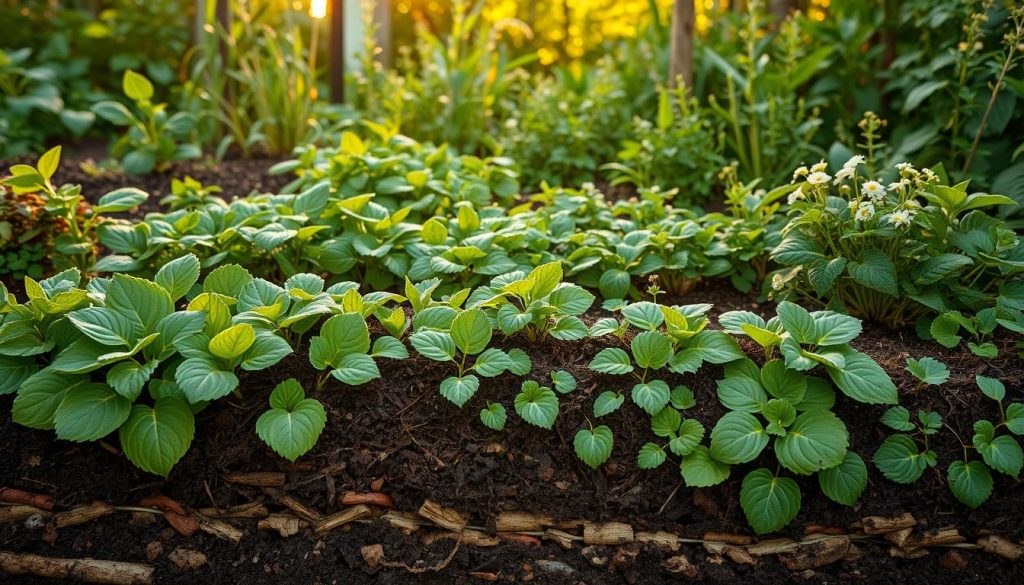
Patricia Lanza’s “Lasagna Gardening” made this method famous. It’s like making a lasagna with layers of “green” and “brown” materials.
“Green” layers have things like grass clippings and coffee grounds. “Brown” layers include dried leaves and cardboard. This mix helps the soil break down and get nutrients.
The lasagna method makes soil rich and ready for plants quickly. You can plant in it soon after making it, thanks to compost on top. It’s great for turning lawns into gardens with little work.
Ruth Stout’s Hay Mulch System
Ruth Stout’s deep mulching with hay changed gardening in the 1950s. Her method cuts out digging, composting, and fertilizing, and needs little weeding.
She used 8-12 inches of hay across her garden. As it breaks down, more hay is added. Seeds or seedlings go into small pockets in the hay. The mulch keeps weeds away, holds moisture, and feeds the soil.
Stout’s method is simple and saves a lot of work. It might not look as neat as other methods, but it’s great for building soil with little effort.
| Method | Primary Materials | Setup Time | Best For | Maintenance Level |
|---|---|---|---|---|
| Sheet Mulching | Cardboard/newspaper, compost, mulch | Moderate | Converting lawn to garden beds | Medium |
| Lasagna Gardening | Alternating green/brown organic materials | High | Building nutrient-rich soil quickly | Low-Medium |
| Ruth Stout System | Primarily hay or straw | Low | Low-maintenance gardening | Very Low |
No-dig gardening has no one “right” way. Many gardeners mix different methods or adjust them for their needs. The beauty of no-dig gardening is its flexibility. Feel free to try different things and find what works best for you.
Getting Started: Creating Your First No-Dig Bed
Ready to change your gardening ways? Starting a no-dig bed is a great first step. It’s easy and works with nature, not against it. I’ll guide you through making your first layered garden bed with simple steps for beginners.
Selecting the Right Location
Choosing the right spot is key for your no-dig garden. Look for a place that gets 6-8 hours of sunlight a day. It should also be close to a water source for easy watering.
Make sure the spot is easy to see and tend to. If you can, put your beds near your kitchen for easy picking. Avoid areas where water collects, as no-dig beds can get waterlogged too.
Materials You’ll Need
Having the right materials makes starting easy. Start with cardboard or newspaper as your base. These will kill weeds and break down over time. Make sure you have enough to cover your bed area with some extra.
For the soil, you’ll need compost, manure, leaf mold, and topsoil. You’ll also need straw, grass clippings, or shredded leaves for mulching. If money is tight, look for free or cheap organic materials at local farms, coffee shops, and compost facilities.
Step-by-Step Bed Creation
Creating your first no-dig bed is a simple process. Start by marking out your bed size. I suggest beds no wider than 4 feet so you can reach the center without stepping on the soil.
Trim any existing plants as short as you can, but don’t remove them. Lay down your cardboard or newspaper, overlapping the edges by at least 6 inches. Make sure to wet this layer well to start the decomposition process.
Next, add a layer of compost or manure as your first layer. Then, alternate between “browns” (like straw) and “greens” (like grass clippings) until you reach a height of 6-12 inches. Water each layer as you go to keep it moist.
Finish with a 2-3 inch layer of compost on top for planting. The best time to start is fall or early winter, but you can begin anytime.
Converting Existing Gardens to No-Dig
Turning existing gardens to no-dig needs a gentle touch. Just stop digging and start adding mulch on top. Use a 1-2 inch layer of compost around plants, avoiding stems and crowns.
When you harvest, cut plants at soil level and let roots decompose. This keeps the soil structure and feeds the soil life. Add more compost or organic matter each season to keep your no-dig system growing.
Starting Fresh on Lawn or Weedy Areas
To convert lawn or weeds, you need to suppress them first. Use thick cardboard or lots of newspaper (at least 10 sheets) to block weeds. Make sure there are no gaps for weeds to grow through.
For really weedy spots, add black plastic or weed fabric under the cardboard. Let the bed settle for 4-6 weeks before planting. This lets the bottom layers break down and control weeds.
Choosing the Right Mulch Materials for Sustainable Gardening
Starting a no-dig garden is all about picking the right mulch. Mulch keeps your soil healthy, stops weeds, and holds moisture. It also feeds your plants as it breaks down. Not all mulches are the same, and your choice affects your garden’s health and upkeep.
Organic Mulch Options
Organic mulches improve your soil as they break down. They help create a thriving garden ecosystem. Here are some organic mulches and their benefits:
- Straw: Great for veggie gardens, it breaks down slowly and looks nice. Make sure it’s seed-free to avoid grass.
- Fallen Leaves: Free in autumn, they decompose fast and add nutrients. Shredding them helps with coverage.
- Grass Clippings: Use them in thin layers to avoid matting. They decompose quickly and give your soil nitrogen.
- Wood Chips: Good for paths and perennial beds, they suppress weeds and last long.
- Compost: It’s full of nutrients and works well as mulch.
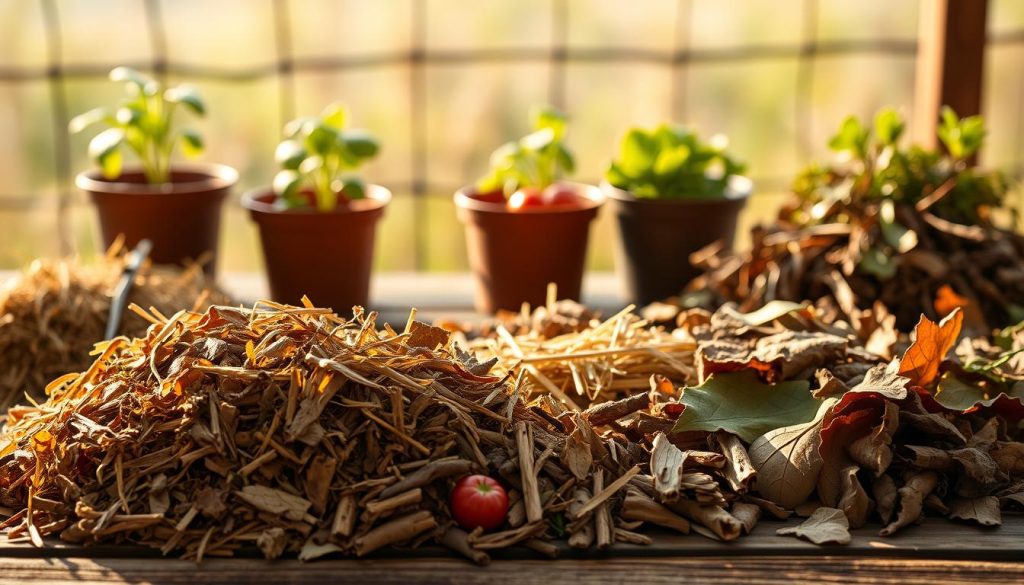
What to Avoid in Your Low-Maintenance Garden
Some mulches can harm your garden more than help. Choosing wisely keeps your garden easy to care for.
Stay away from hay with seeds, as it can turn your garden into a weed field. Don’t use diseased plants, as they can spread disease. Fresh wood chips or sawdust can take nitrogen from your soil as they break down.
Synthetic mulches like rubber or plastic are okay in some cases but don’t help your soil. Colored mulches might have dyes that aren’t good for organic gardening.
The best mulch is often what’s local. Using local materials saves money and is better for the environment. Try different mulches to see what works best for your garden.
Seasonal Maintenance in a No-Dig Garden
No-dig gardens need less work than regular gardens. They start with a gentle setup that lasts all year. This means less work and healthier soil.
Each season in a no-dig garden has its own needs. But, the work is always less than in traditional gardens.
Spring Preparations and Planting
When spring comes, your no-dig garden is easy to get ready. Just add a thin layer of compost on top of the mulch. This lets the soil’s creatures mix it in naturally.
To plant, lift the mulch, make small holes in the compost, and put in your seedlings. For seeds, make narrow furrows in the compost. Weeds are easy to pull out because they haven’t grown deep.
Summer Care and Ongoing Mulching
In summer, focus on mulching in your no-dig garden. Add organic mulch to keep moisture in and weeds out. This can cut down your water use by half.
For new plants in the middle of the season, just add a bit of compost and plant. You don’t need to till the soil, saving time and keeping the soil healthy.
Fall and Winter Management
At the end of the season, clean up your no-dig garden a little. Take out big plant debris, but leave the rest to break down. Cover the soil with compost and mulch to keep it warm in winter.
Use winter cover crops like clover or rye. Cut them down in spring to use as mulch. This keeps the soil healthy and adds organic matter. Winter is a time for the garden to rest, but the soil keeps working under the mulch.
| Season | No-Dig Garden Tasks | Traditional Garden Tasks | Time Savings |
|---|---|---|---|
| Spring | Add compost layer, plant directly | Till soil, remove weeds, amend soil | 60-70% |
| Summer | Light mulching, spot weeding | Regular weeding, cultivation | 40-50% |
| Fall | Remove large debris, add protective mulch | Clear all debris, till soil, add amendments | 50-60% |
| Winter | Minimal intervention, plan next season | Soil preparation, structure building | 80-90% |
Integrating No-Dig with Permaculture Gardening
No-dig gardening and permaculture share common goals. They aim to work with nature, disturb it less, and improve soil health naturally. Together, they make gardens that need less care but produce more.
Permaculture designs systems where each part helps the others. No-dig beds are great for these systems. They have better soil and more life, perfect for growing many plants together.
Companion Planting in No-Dig Systems
The soil in no-dig gardens is full of life. This helps plants work better together. They share nutrients and warnings through fungal networks.
No-dig beds are perfect for plants that help each other. Tomatoes and basil grow well together. Basil keeps pests away and makes tomatoes taste better.
The “three sisters” method works great here too. Corn, beans, and squash grow together. Corn supports beans, beans fix nitrogen, and squash keeps the soil cool and weeds away.
In no-dig gardens, plants of different depths can grow together. Carrots and lettuce can share space without fighting for nutrients.
| Primary Plant | Beneficial Companions | Benefits in No-Dig Systems | Plants to Avoid |
|---|---|---|---|
| Tomatoes | Basil, Marigolds, Nasturtiums | Pest deterrence, flavor enhancement | Potatoes, Fennel |
| Brassicas | Aromatic herbs, Onions | Reduced pest pressure, space efficiency | Strawberries, Tomatoes |
| Carrots | Onions, Lettuce, Rosemary | Pest confusion, vertical space utilization | Dill, Parsnips |
| Beans | Corn, Squash, Marigolds | Nitrogen fixation, structural support | Onions, Garlic |
Creating Sustainable Garden Ecosystems
No-dig gardening changes the whole garden. It works with permaculture to make a landscape that’s good for the planet. Close to the house, you can have easy-to-reach herbs. Further out, less demanding crops grow.
Water use is better in no-dig permaculture gardens. The soil holds water, reducing runoff. Swales help water reach plants, saving water.
These gardens are great for wildlife. Insects and birds find food and shelter here. This natural control helps plants grow without needing chemicals. The soil also protects bees and other pollinators.
By mixing no-dig with permaculture, gardens get better every year. They become more productive and need less care. This shows how natural gardening can be good for us and the planet.
No-Dig Gardening for Different Growing Contexts
No-dig gardening is great for all kinds of gardeners, from those with tiny balconies to big farmers. It’s all about working with nature, not against it. You can adjust the method to fit your garden’s size and needs.
Adapting for Small Spaces and Urban Gardens
Even with little space, you can still garden. No-dig gardening is perfect for cities where every inch matters. For balconies, use fabric grow bags or shallow containers with compost and mulch.
Vertical gardening fits well with no-dig. Attach pocket planters to walls or railings and fill them with compost. Window boxes can also become no-dig gardens with the right setup.
For small yards, raised beds are a good choice. A 4×4 foot bed can grow a lot of food with no-dig. Build up with layers to use your space well.
Scaling Up: No-Dig in Larger Gardens and Farms
For bigger areas, efficiency is key. Market gardeners and small farmers use no-dig beds to manage their land better. It takes more materials at first, but it’s worth it in the long run.
Big gardens need special tools. Broadforks and compost spreaders make no-dig easier. Many farmers save a lot of time and money with no-dig.
Cost is a big factor in growing no-dig. At first, it might seem more expensive than traditional farming. But, no-dig is often more profitable over time because it saves money and improves soil.
| Garden Scale | Recommended Mulch Depth | Initial Setup Time | Maintenance Hours (Monthly) | Suitable Crops |
|---|---|---|---|---|
| Container/Balcony | 1-2 inches | 1-2 hours | 1-2 hours | Herbs, greens, dwarf varieties |
| Small Urban Plot | 2-4 inches | 4-8 hours | 2-4 hours | Mixed vegetables, small fruits |
| Suburban Garden | 4-6 inches | 8-16 hours | 4-6 hours | Full range of vegetables, berries |
| Market Garden/Farm | 4-8 inches | 40+ hours | 15-20 hours | Commercial crops, rotational planning |
Common Challenges and Organic Solutions
Dealing with no-dig gardening challenges gets easier with natural remedies and prevention. This method builds strong gardens over time. But, new gardeners might face some hurdles. Knowing these issues and having organic solutions helps keep your garden healthy without chemicals.
Addressing Pest Issues Naturally
No-dig gardens attract pests like slugs and snails at first. Instead of chemicals, use copper tape barriers or beer traps. These methods are safe for your garden.
Encourage good bugs to fight pests. Use nematodes for slugs or attract ground beetles and birds. Aromatic herbs like rosemary and thyme also keep pests away.
It’s normal to see more pests when starting no-dig gardening. But, as your garden grows, it will balance out. This balance is key to a successful garden.
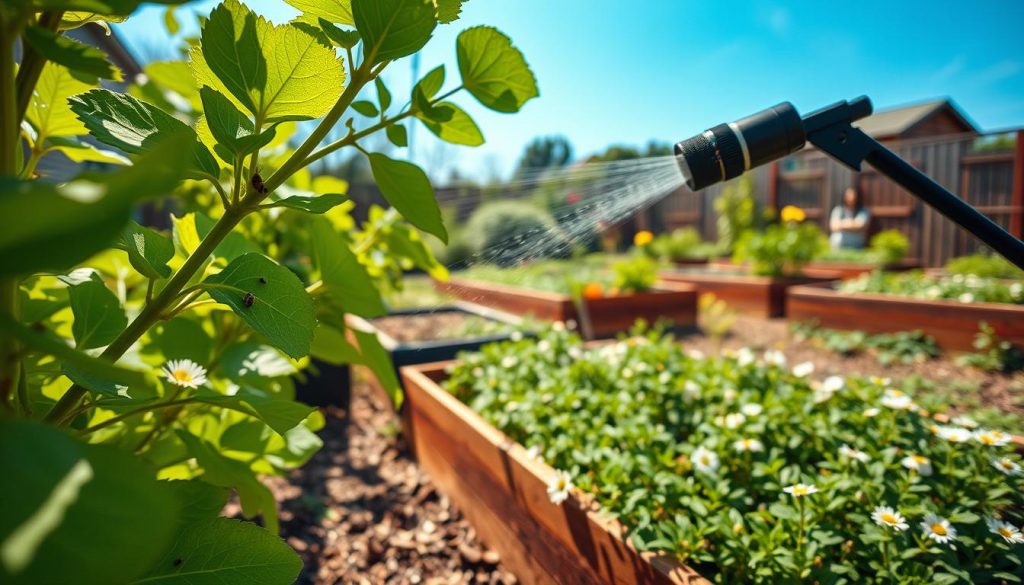
Troubleshooting Nutrient Deficiencies
Even with mulch, plants might show nutrient needs. Yellow leaves mean nitrogen, purple leaves mean phosphorus, and brown edges mean potassium.
Fix these with organic surface amendments. Use compost tea or alfalfa meal for nitrogen. Bone meal or rock phosphate help with phosphorus.
Comfrey leaves are great for potassium. Wood ash, used carefully, helps with potassium and calcium. No-dig gardens let worms and soil life do the work for you.
Nutrient problems usually get better over time. With patience and organic care, your plants will need less help.
My Personal Journey with Layered Gardening
My journey with layered gardening began with skepticism but turned into a deep passion. I had fought weeds, tilled soil, and struggled with poor harvests for years. Then, I decided to try this “lazy gardening” method that seemed too good to be true. This journey changed not just my garden but also my way of thinking about growing food.
Mistakes Made and Lessons Learned
My early tries at no-dig gardening were filled with mistakes. One big error was using too thin mulch layers. I spread just an inch of compost, expecting magic, but weeds pushed through in weeks.
Choosing the right materials was also hard. I used fresh grass clippings and uncomposted manure, which burned young plants and attracted pests. I learned that aged materials are key.
My biggest mistake was expecting quick results. No-dig gardens take seasons, not days. When my plants didn’t grow fast, I almost gave up. But I kept going and saw the soil change over time.
Unexpected Benefits I’ve Discovered
Layered gardening has brought surprises beyond weed control and soil health. It has led to a biodiversity explosion. My garden now has beneficial insects, creating a natural pest control system.
The growing season has also been a surprise. Thick mulch layers keep soil warm, letting me plant earlier and harvest later than others.
Most surprisingly, no-dig gardening has brought mental benefits. It’s satisfying to work with nature instead of against it. This approach has made gardening a partnership, not a battle.
| Expectation | Reality | Lesson Learned |
|---|---|---|
| Quick results | Gradual improvement over seasons | Patience yields greater rewards |
| Any organic material works | Material quality matters significantly | Choose well-aged compost and proper mulch |
| More work initially, less later | Moderate work consistently | Consistent small efforts outperform occasional big ones |
| Primarily saves labor | Improves ecosystem, extends seasons, enhances enjoyment | The benefits extend far beyond convenience |
Why No-Dig Gardening Is the Future of Home Growing
No-dig gardening is a simple yet powerful solution to our environmental challenges. It’s not just about growing food. It’s about healing our relationship with the earth.
By choosing no-dig methods, you join a global movement. This movement protects soil health and produces abundant harvests. Each no-dig plot acts as a carbon sink, reducing greenhouse gases.
Sustainable gardening is accessible to everyone. It works for small balconies or large acres. As more people adopt these methods, we build a network of healthy soil systems.
Research shows that working with nature is better than fighting it. No-dig gardening combines old wisdom with new soil biology knowledge.
Your garden can inspire others. Friends will be amazed by your thriving plants and low weeding. Sharing the no-dig approach can spread sustainable practices far and wide.
Start with what you have. Every mulched bed and undisturbed soil patch helps our planet. Your garden matters, and its impact will grow with each season.

